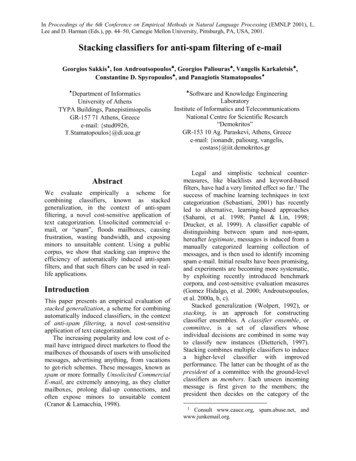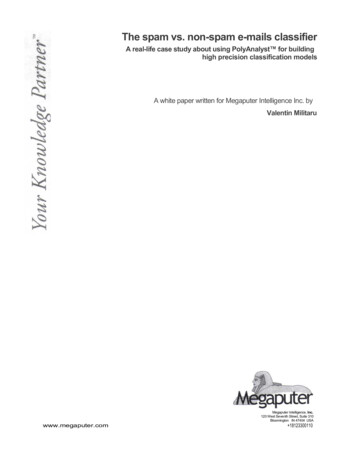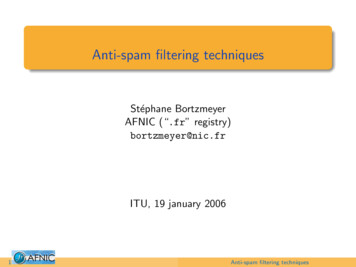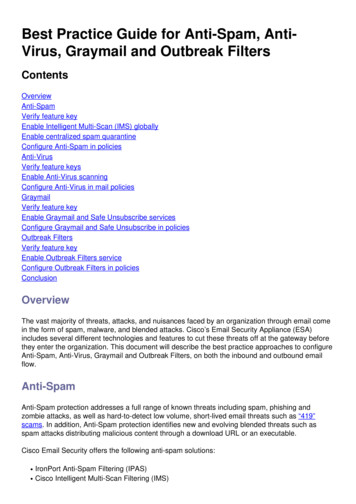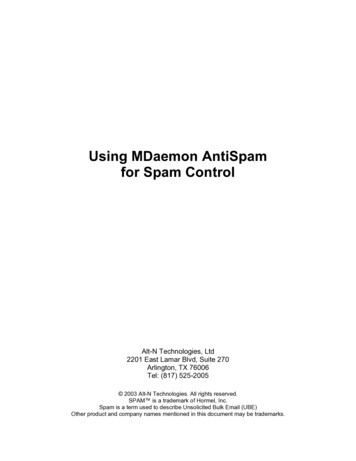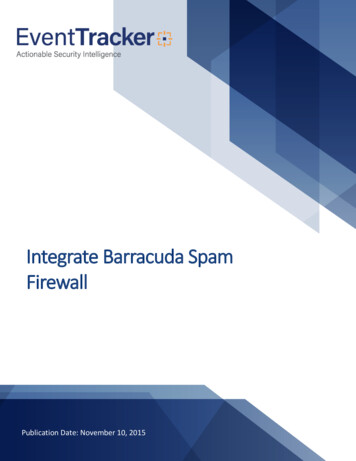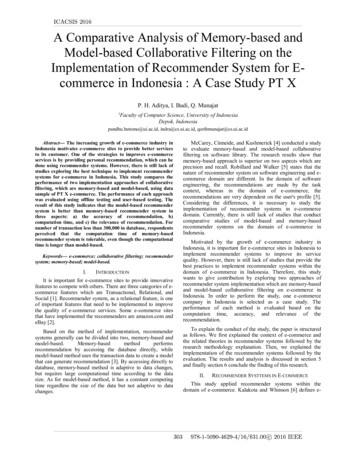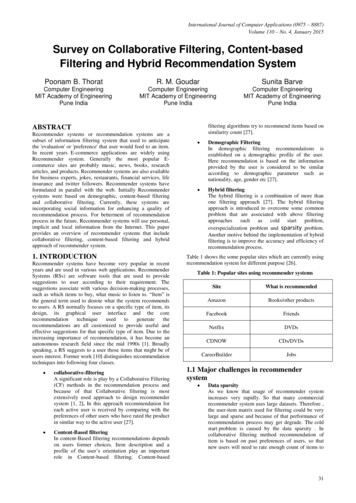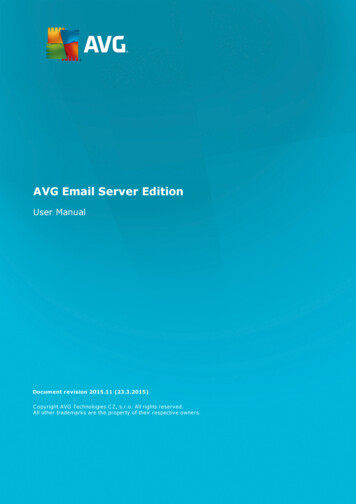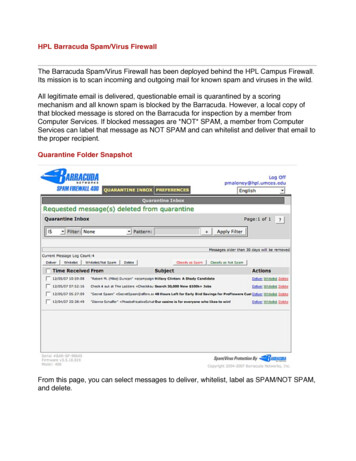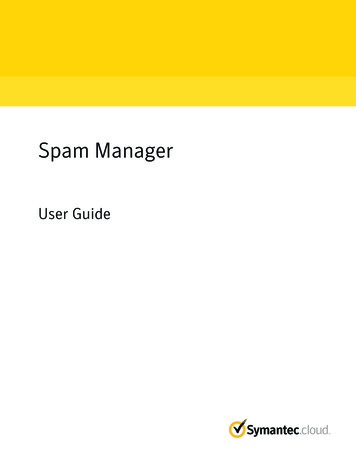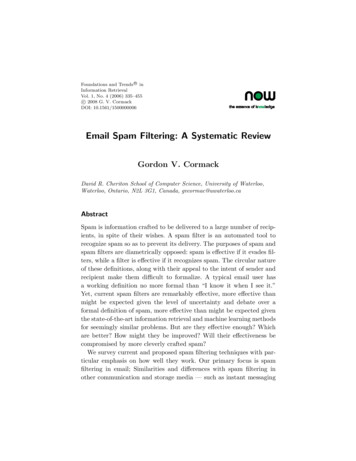
Transcription
RFoundations and Trends inInformation RetrievalVol. 1, No. 4 (2006) 335–455c 2008 G. V. Cormack DOI: 10.1561/1500000006Email Spam Filtering: A Systematic ReviewGordon V. CormackDavid R. Cheriton School of Computer Science, University of Waterloo,Waterloo, Ontario, N2L 3G1, Canada, gvcormac@uwaterloo.caAbstractSpam is information crafted to be delivered to a large number of recipients, in spite of their wishes. A spam filter is an automated tool torecognize spam so as to prevent its delivery. The purposes of spam andspam filters are diametrically opposed: spam is effective if it evades filters, while a filter is effective if it recognizes spam. The circular natureof these definitions, along with their appeal to the intent of sender andrecipient make them difficult to formalize. A typical email user hasa working definition no more formal than “I know it when I see it.”Yet, current spam filters are remarkably effective, more effective thanmight be expected given the level of uncertainty and debate over aformal definition of spam, more effective than might be expected giventhe state-of-the-art information retrieval and machine learning methodsfor seemingly similar problems. But are they effective enough? Whichare better? How might they be improved? Will their effectiveness becompromised by more cleverly crafted spam?We survey current and proposed spam filtering techniques with particular emphasis on how well they work. Our primary focus is spamfiltering in email; Similarities and differences with spam filtering inother communication and storage media — such as instant messaging
and the Web — are addressed peripherally. In doing so we examine thedefinition of spam, the user’s information requirements and the roleof the spam filter as one component of a large and complex information universe. Well-known methods are detailed sufficiently to makethe exposition self-contained, however, the focus is on considerationsunique to spam. Comparisons, wherever possible, use common evaluation measures, and control for differences in experimental setup. Suchcomparisons are not easy, as benchmarks, measures, and methods forevaluating spam filters are still evolving. We survey these efforts, theirresults and their limitations. In spite of recent advances in evaluationmethodology, many uncertainties (including widely held but unsubstantiated beliefs) remain as to the effectiveness of spam filtering techniquesand as to the validity of spam filter evaluation methods. We outline several uncertainties and propose experimental methods to address them.
1IntroductionThe Spam Track at the Text Retrieval Conference (TREC) definesemail spam as“Unsolicited, unwanted email that was sent indiscriminately, directly or indirectly, by a sender having no current relationship with the recipient.” [40]Although much of the history of spam is folklore, it is apparent thatspam was prevalent in instant messaging (Internet Relay Chat, orIRC) and bulletin boards (Usenet, commonly dubbed newsgroups)prior to the widespread use of email. Spam countermeasures are asold as spam, having progressed from ad hoc intervention by administrators through simple hand-crafted rules through automatic methodsbased on techniques from information retrieval and machine learning,as well as new methods specific to spam. Spam has evolved so as todefeat countermeasures; countermeasures have evolved so as to thwartevasion.We generalize the TREC definition of spam to capture the essentialadversarial nature of spam and spam abatement.335
336 IntroductionSpam: unwanted communication intended to be delivered to an indiscriminate target, directly or indirectly,notwithstanding measures to prevent its delivery.Spam filter: an automated technique to identify spamfor the purpose of preventing its delivery.Applying these definitions requires the adjudication of subjective termslike intent and purpose. Furthermore, any evaluation of spam filteringtechniques must consider their performance within the context of howwell they fulfill their intended purpose while avoiding undesirable consequences. It is tempting to conclude that scientific spam filter evaluationis therefore impossible, and that the definition of spam or the choiceof one filter over another is merely a matter of taste. Or to concludethat the subjective aspects can be “defined away” thus reducing spamfilter evaluation to a simple mechanical process. We believe that bothconclusions are specious, and that sound quantitative evaluation canand must be applied to the problem of spam filtering.While this survey confines itself to email spam, we note that the definitions above apply to any number of communication media, includingtext and voice messages [31, 45, 84], social networks [206], and blogcomments [37, 123]. It applies also to web spam, which uses a searchengine as its delivery mechanism [187, 188].1.1The Purpose of SpamThe motivation behind spam is to have information delivered to therecipient that contains a payload such as advertising for a (likelyworthless, illegal, or non-existent) product, bait for a fraud scheme,promotion of a cause, or computer malware designed to hijack the recipient’s computer. Because it is so cheap to send information, only a verysmall fraction of targeted recipients — perhaps one in ten thousand orfewer — need to receive and respond to the payload for spam to beprofitable to its sender [117].A decade ago (circa 1997), the mechanism, payload, and purpose ofspam were quite transparent. The majority of spam was sent by “cottage industry” spammers who merely abused social norms to promote
1.1 The Purpose of Spam337Fig. 1.1 Marketing spam.their wares (Figure 1.1). Fraud bait consisted of clumsily written“Nigerian scams” (Figure 1.2) imploring one to send bank transit information so as to receive several MILLION DOLLARS from an aide tosome recently deposed leader. Cause promotion took the form of obvious chain letters (Figure 1.3), while computer viruses were transmittedas attached executable files (Figure 1.4). Yet enough people receivedand responded to these messages to make them lucrative, while theirvolume expanded to become a substantial inconvenience even to thosenot gullible enough to respond.At the same time, spamming has become more specialized andsophisticated, with better hidden payloads and more nefarious purposes. Today, cottage industry spam has been overwhelmed by spamsent in support of organized criminal activity, ranging from traffic inillegal goods and services through stock market fraud, wire fraud, identity theft, and computer hijacking [140, 178]. Computer viruses are nolonger the work of simple vandals, they are crafted to hijack computersso as to aid in identity theft and, of course, the perpetration of morespam!
338 IntroductionFig. 1.2 Nigerian spam.Fig. 1.3 Chain letter spam.
1.2 Spam Characteristics339Fig. 1.4 Virus spam.Spam, to meet its purpose, must necessarily have a payload whichis delivered and acted upon1 in the intended manner. Spam abatementtechniques are effective to the extent that they prevent delivery, preventaction, or substitute some other action that acts as a disincentive.2Spam filters, by identifying spam, may be used in support of any ofthese techniques. At the same time, the necessary existence of a payloadmay aid the filter in its purpose of identifying spam.1.2Spam CharacteristicsSpam in all media commonly share a number of characteristics thatderive from our definition and discussion of the purpose of spam.1 Thetarget need not be a person; a computer may receive and act upon the spam, servingits purpose just as well.2 Such as arresting the spammer.
340 Introduction1.2.1UnwantedIt seems obvious that spam messages are unwanted, at least by the vastmajority of recipients. Yet some people respond positively to spam, asevidenced by the fact that spam campaigns work [71]. Some of theseindividuals no doubt come to regret having responded, thus callinginto question whether they indeed wanted to receive the spam in thefirst place. Some messages — such as those trafficking in illegal goodsand services — may be wanted by specific individuals, but classed asunwanted by society at large. For most messages there is broad consensus as to whether or not the message is wanted, for a substantial minority (perhaps as high as 3% [168, 199]) there is significant disagreementand therefore some doubt as to whether the message is spam or not.1.2.2IndiscriminateSpam is transmitted outside of any reasonable relationship3 or prospective relationship between the sender and the receiver. In general, it ismore cost effective for the spammer to send more spam than to beselective as to its target. An unwanted message targeting a specificindividual, even if it promotes dubious products or causes or containsfraud bait or a virus, does not meet our definition of spam.A message that is automatically or semi-automatically tailored toits target is nonetheless indiscriminate. For example, a spammer mayharvest the name of the person owning a particular email address andinclude that name in the salutation of the message. Or a spammer maydo more sophisticated data mining and sign the message with the nameand email address of a colleague or collaborator, and may include inthe text subjects of interest to the target. The purpose of such tailoringis, of course, to disguise the indiscriminate targeting of the message.1.2.3DisingenuousBecause spam is unwanted and indiscriminate, it must disguise itselfto optimize the chance that its payload will be delivered and acted3 Wehave dropped the term unsolicited used in TREC and earlier definitions of spam,because not all unsolicited email is spam, and that which is captured by our notion ofindiscriminate. Solicited email, on the other hand, is clearly not indiscriminate.
1.2 Spam Characteristics341upon. The possible methods of disguise are practically unlimited andcannot be enumerated in this introduction (cf. [27, 67, 75]). Some ofthe most straightforward approaches are to use plausible subject andsender data, as well as subject material that appears to be legitimate.It is common, for example, to receive a message that appears to be acomment from a colleague pertaining to a recent news headline. Evenmessages with random names; for example a wire transfer from Johnto Judy, will appear legitimate to some fraction of its recipients. Messages purporting to contain the latest security patch from Microsoftwill similarly be mistaken for legitimate by some fraction of recipients.Spam must also disguise itself to appear legitimate to spam filters.Word misspelling or obfuscation, embedding messages in noisy images,and sending messages from newly hijacked computers, are spam characteristics designed to fool spam filters. Yet humans — or filters employing different techniques — can often spot these characteristics as uniqueto spam.1.2.4Payload BearingThe payload of a spam message may be obvious or hidden; in eithercase spam abatement may be enhanced by identifying the payload andthe mechanism by which actions triggered by it profit the spammer.Obvious payloads include product names, political mantras, web links,telephone numbers, and the like. These may be in plain text, or theymay be obfuscated so as to be readable by the human but appear benignto the computer. Or they may be obfuscated so as to appear benign tothe human but trigger some malicious computer action.The payload might consist of an obscure word or phrase like“gouranga” or “platypus race” in the hope that the recipient will becurious and perform a web search and be delivered to the spammer’sweb page or, more likely, a paid advertisement for the spammer’s webpage. Another form of indirect payload delivery is backscatter : Thespam message is sent to a non-existent user on a real mail server, withthe (forged) return address of a real user. The mail server sends an“unable to deliver” message to the (forged) return address, attachingand thus delivering the spam payload. In this scenario we consider
342 Introductionboth the original message (to the non-existent user) and the “unableto deliver” message to be spam, even though the latter is transmittedby a legitimate sender.The payload might be the message itself. The mere fact that themessage is not rejected by the mail server may provide informationto the spammer as to the validity of the recipient’s address and thenature of any deployed spam filter. Or if the filter employs a machinelearning technique, the message may be designed to poison the filter[70, 72, 191], compromising its ability to detect future spam messages.1.3Spam ConsequencesThe transmission of spam — whether or not its payload is deliveredand acted upon — has several negative consequences.1.3.1Direct ConsequencesSpam provides an unregulated communication channel which can beused to defraud targets outright, to sell shoddy goods, to install viruses,and so on. These consequences are largely, but not exclusively, borne bythe victims. For example, the victim’s computer may be used in furtherspamming or to launch a cyber attack. Similarly, the victim’s identitymay be stolen and used in criminal activity against other targets.1.3.2Network Resource ConsumptionThe vast majority of email traffic today is spam. This traffic consumesbandwidth and storage, increasing the risk of untimely delivery or outright loss of messages. For example, during the Sobig virus outbreak of2003, the author’s spam filter correctly identified the infected messagesas spam and placed them in a quarantine folder. However, the totalvolume of such messages exceeded 5 GB per day, quickly exhaustingall available disk space resulting in non-delivery of legitimate messages.1.3.3Human Resource ConsumptionIt is an unpleasant experience and a waste of time to sort throughan inbox full of spam. This process necessarily interferes with the
1.4 The Spam Ecosystem343timeliness of email because the recipient is otherwise occupied sortingthrough spam. Furthermore, the frequent arrival of spam may precludethe use of email arrival alerts, imposing a regimen of batch rather thanon-arrival email reading, further compromising timeliness.Over and above the wasted time of routinely sifting through spam,some spam messages may consume extraordinary time and resourcesif they appear legitimate and cannot be dismissed based on the summary information presented by the mail reader’s user interface. Moreimportantly, legitimate email messages may be overlooked or dismissedas spam, with the consequence that the message is missed.A spam filter may mitigate any or all of the problems associatedwith human resource consumption, potentially reducing effort whilealso enhancing timeliness and diminishing the chance of failing to reada legitimate message.1.3.4Lost EmailSections 1.3.2 and 1.3.3 illustrate situations in which spam may causelegitimate email to be lost or overlooked. Spam abatement techniquesmay, of course, also cause legitimate email to be lost. More generally, spam brings the use of email into disrepute and therefore discourages its use. Users may refuse to divulge their email addresses or mayobfuscate them in ways that inhibit the use of email as a medium tocontact them.In evaluating the consequences of email loss (or potential loss), onemust consider the probability of loss, the importance and time criticality of the information, and the likelihood of receiving the information,or noticing its absence, via another medium. These consequences varyfrom message to message, and must be considered carefully in evaluating the effectiveness of any approach to spam abatement, includinghuman sorting.1.4The Spam EcosystemSpam and spam filters are components of a complex interdependentsystem of social and technical structures. Many spam abatement proposals seek to alter the balance within the system so as to render
344 Introductionspam impractical or unprofitable. Two anonymous whimsical articles[61, 1] illustrate the difficulties that arise with naive efforts to findthe Final Ultimate Solution to the Spam Problem (FUSSP). Crocker[43] details the social issues and challenges in effecting infrastructurebased solutions such as protocol changes and sender authentication.Legislation, prosecution and civil suits have been directed at spammers [101, 124], however, the international and underground nature ofmany spam operations makes them difficult to target. Spammers andlegitimate advertisers have taken action against spam abatement outfits [119]. Vigilante actions have been initiated against spammers, andspammers have reacted in kind with sabotage and extortion [103]. Economic and technical measures have been proposed to undermine theprofitability of spam [89, 138].A detailed critique of system-wide approaches to spam abatement isbeyond the scope of this survey, however, it is apparent that no FUSSPhas yet been found nor, we daresay, is likely to be found in the nearfuture. And even if the email spam problem were to be solved, it isnot obvious that the solution would apply to spam in other media. Thegeneral problem of adversarial information filtering [44] — of whichspam filtering is the prime example — is likely to be of interest forsome time to come.We confine our attention to this particular problem — identifyingspam — while taking note of the fact that the deployment of spamfilters will affect the spam ecosystem, depending on the nature of theirdeployment. The most obvious impact of spam filtering is the emergence of technical countermeasures in spam; it is commonly held thatfiltering methods become obsolete as quickly as they are invented. Legalretaliation is also a possibility: Spammers or advertisers or recipientsmay sue for damages due to the non-delivery of messages. Spam filtering is itself a big business, a tremendous amount of money rests onour perception of which spam methods work best, so the self-interestof vendors may be at odds with objective evaluation. And filter marketshare will itself influence the design of spam.In general, we shall consider the marginal or incremental effects ofspam filter deployment, and mention in passing its potential role inrevolutionary change.
1.5 Spam Filter Inputs and Outputs1.5345Spam Filter Inputs and OutputsWe have defined a spam filter to be an automated technique to identifyspam. A spam filter with perfect knowledge might base its decision onthe content of the message, characteristics of the sender and the target,knowledge as to whether the target or others consider similar messagesto be spam, or the sender to be a spammer, and so on. But perfectknowledge does not exist and it is therefore necessary to constrainthe filter to use well defined information sources such as the contentof the message itself, hand-crafted rules either embedded in the filteror acquired from an external source, or statistical information derivedfrom feedback to the filter or from external repositories compiled bythird parties.The desired result from a spam filter is some indication of whetheror not a message is spam. The simplest result is a binary categorization — spam or non-spam — which may be acted upon in various waysby the user or by the system. We call a filter that returns such a binarycategorization a hard classifier. More commonly, the filter is required togive some indication of how likely it considers the message to be spam,either on a continuous scale (e.g., 1 sure spam; 0 sure non-spam)or on an ordinal categorical scale (e.g., sure spam, likely spam, unsure,likely non-spam, sure non-spam). We call such a filter a soft classifier.Many filters are internally soft classifiers, but compare the soft classification result to a sensitivity threshold t yielding a hard classifier. Usersmay be able to adjust this sensitivity threshold according to the relative importance they ascribe to correctly classifying spam vs. correctlyclassifying non-spam (see Section 1.7).A filter may also be called upon to justify its decision; for example,by highlighting the features upon which it bases is classification. Thefilter may also classify messages into different genres of spam and goodmail (cf. [42]). For example, spam might be advertising, phishing or aNigerian scam, while good email might be a personal correspondence, anews digest or advertising. These genres may be important in justifyingthe spam/non-spam classification of a message, as well in assessingits impact (e.g., does the user really care much about the distinctionbetween spam and non-spam advertising?).
346 Introduction1.5.1Typical Email Spam Filter DeploymentFigure 1.5 outlines the typical use of an email spam filter from the perspective of a single user. Incoming messages are processed by the filterone at a time and classified as ham (a widely used colloquial term fornon-spam) or spam. Ham is directed to the user’s inbox which is readregularly. Spam is directed to a quarantine file which is irregularly (orExternalIncoming chGoodEmailMisclassifiedGood EmailRead EmailMisclassified SpamFig. 1.5 Spam filter usage.
1.5 Spam Filter Inputs and Outputs347never) read but may be searched in an attempt to find ham messageswhich the filter has misclassified. If the user discovers filter errors —either spam in the inbox or ham in the quarantine — he or she mayreport these errors to the filter, particularly if doing so is easy and heor she feels that doing so will improve filter performance. In classifyinga message, the filter employs the content of the message, its built-inknowledge and algorithms, and also, perhaps, its memory of previousmessages, feedback from the user, and external resources such as blacklists [133] or reports from other users, spam filters, or mail servers. Thefilter may run on the user’s computer, or may run on a server where itperforms the same service for many users.1.5.2Alternative Deployment ScenariosThe filter diagrammed in Figure 1.5 is on-line in that it processes onemessage at a time, classifying each in turn before examining the next.Furthermore, it is passive in that it makes use only of information athand when the message is examined. Variants of this deployment arepossible, only some of which have been systematically investigated: Batch filtering, in which several messages are presented to thefilter at once for classification. This method of deploymentis atypical in that delivery of messages must necessarily bedelayed to form a batch. Nevertheless, it is conceivable thatfilters could make use of information contained in the batchto classify its members more accurately than on-line. Batch training, in which messages may be classified online, but the classifier’s memory is updated only periodically.Batch training is common for classifiers that involve muchcomputation, or human intervention, in harnessing new information about spam. Just-in-time filtering, in which the classification of messages is driven by client demand. In this deployment a filterwould defer classification until the client opened his or hermail client, sorting the messages in real-time into inbox andquarantine.
348 Introduction Deferred or tentative classification, in which the classificationof messages by the filter is uncertain, and either delivery ofthe message is withheld or the message is tentatively classified as ham or spam. As new information is gleaned, theclassification of the message may be revised and, if so, it isdelivered or moved to the appropriate file. Receiver engagement, in which the filter probes the recipient (or an administrator representing the recipient) to gleanmore information as a basis for classification. Active learning may occur in real-time (i.e., the information is gatheredduring classification) or in conjunction with deferred or tentative classification. An example of real-time active learningmight be a user interface that solicits human adjudicationfrom the user as part of the mail reading process. A morepassive example is the use of an “unsure” folder into whichmessages are placed with the expectation that the user willadjudicate the messages and communicate the result to thefilter. Sender engagement, in which the filter probes the senderor the sender’s machine for more information. Examples arechallenge–response systems and greylisting. These filters mayhave a profound effect on the ecosystem as they, through theirprobes, transmit information back to the sender. Furthermore, they introduce delays and risks of non-delivery thatare difficult to assess [106]. It may be argued that these techniques which engage the sender do not fit our notion of “filter.” Nevertheless, they are commonly deployed in place of,or in conjunction with, filters and so their effects must beconsidered. Collaborative filtering, in which the filter’s result is used notonly to classify messages on behalf of the user, but to provide information to other filters operating on behalf of otherusers. The motivation for collaborative filtering is that spamis sent in bulk, as is much hard-to-classify good email, somany other users are likely to receive the same or similarmessages. Shared knowledge among the filters promises to
1.6 Spam Filter Evaluation349make such spam easier to detect. Potential pitfalls includerisks to privacy and susceptibility to manipulation by malicious participants. Social network filtering, in which the sender and recipient’scommunication behavior are examined for evidence that particular messages might be spam.1.6Spam Filter EvaluationScientific evaluation, critical to any investigation of spam filters,addresses fundamental questions: Is spam filtering a viable tool for spam abatement?What are the risks, costs, and benefits of filter use?Which filtering techniques work best?How well do they work?Why do they work?How may they be improved?The vast breadth of the spam ecosystem and possible abatement techniques render impossible the direct measurement of these quantities;there are simply too many parameters for any single evaluation orexperiment to measure all their effects at once. Instead, we make various simplifying assumptions which hold many of the parameters constant, and conduct an experiment to measure a quantity of interestsubject to those assumptions. Such experiments yield valuable insight,particularly if the assumptions are reasonable and the quantities measured truly illuminate the question under investigation. The validity ofan experiment may be considered to have two aspects: internal validity and external validity or generalizability. Internal validity concernsthe veracity of the experimental results under the test conditions andstated assumptions; external validity concerns the generalizability ofthese results to other situations where the stated assumptions, or hidden assumptions, may or may not hold. Establishing internal validityis largely a matter of good experimental design; establishing external validity involves analysis and repeated experiments using differentassumptions and designs.
350 IntroductionIt is all too easy to fix on one experimental design and set of testconditions and to lose sight of the overall question being posed. It issimilarly all too easy to dismiss the results a particular experiment dueto the limitations inherent in its assumptions. For example, filters arecommonly evaluated using tenfold cross validation [95], which assumesthat the characteristics of spam are invariant over time. It would bewrong to conclude, without evidence, that the results of tenfold crossvalidation would be the same under a more realistic assumption. Itwould be equally wrong to dismiss out of hand the results of experiments using this method, to do so would entail dismissal of all scientific evidence, as there is no experiment without limiting assumptions.We would be left with only testimonials, or our own uncontrolled andunrepeatable observations, to judge the efficacy of various techniques.Instead, it is appropriate to identify assumptions that limit the generalizability of current results, and to conduct experiments to measuretheir effect.The key to evaluation is to conduct experiments that glean themost informative results possible with reasonable effort, at reasonablecost, in a reasonable time frame. Simple assumptions — such as theassumption that the characteristics of spam are time-invariant — yieldsimple experiments whose internal validity is easy to establish. Manysuch experiments may reasonably be conducted to explore the breadthof solutions and deployment scenarios. Further experiments, with different simple assumptions, help to establish the external validity of theresults. These experiments serve to identify the parameters and solutions of interest, but are inappropriate for evaluating fine differences.Experimental designs that more aptly model real filter deployment tendto be more complex and costly due to challenges in logistics, controllingconfounding factors, and precisely measuring results. Such experimentsare best reserved for methods and parameters established to be of interest by simpler ones.Among the common assumptions in spam filter evaluation are: Batch or on-line filtering. Existence of training examples. Accurate “true” classification for training messages.
1.7 Evaluation Measures 351Accurate “true” classification for test messages.Recipient behavior, e.g., reporting errors.Sender behavior, e.g., resending dropped messages.Availability of information, e.g., whitelists, blacklists, rulebases, community adjudication, etc.Language of messages to be filtered, e.g., English only.Format of messages to be filtered, e.g., text, html, ASCII,Unicode, etc.Quantifiable consequences for misclassification or delay [96].Time invariance of message characteristics [57].Effect (or non-effect) of spam filter on sender.Effect (or non-effect) of spam filter on recipient.Laboratory and field experiments play complementary roles in scientific investigation. Laboratory experiments investigate the fundamentalproperties of filters under controlled conditions that facilitate reproducibility, precise measurement, a
Email Spam Filtering: A Systematic Review Gordon V. Cormack David R. Cheriton School of Computer Science, University of Waterloo, Waterloo, Ontario, N2L 3G1, Canada, gvcormac@uwaterloo.ca Abstract Spam is information crafted to be delivered to a large number of recip-ients, in spite of their wishes. A spam filter is an automated tool to
